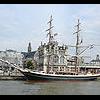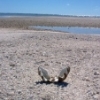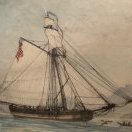-
Posts
86 -
Joined
-
Last visited
Reputation Activity
-
 Lou van Wijhe got a reaction from Chasseur in CUTTY SARK by keelhauled - Mantua - kit bashed - First wooden ship build
Lou van Wijhe got a reaction from Chasseur in CUTTY SARK by keelhauled - Mantua - kit bashed - First wooden ship build
The 3 plans by Campbell are the ones made for re-rigging the ship in the nineteen fifties (source: Paper "The Restoration of the Cutty Sark" by Frank G.G. Carr. Read in London at a meeting of the R.I.N.A. on March 24, 1965). The name changes from Cutty Sark Preservation Society to Cutty Sark Trust etc. have to do with organisational changes; there are no different Campbell sets (albeit ones of different copy quality).
Lou
-
 Lou van Wijhe got a reaction from Chasseur in CUTTY SARK by keelhauled - Mantua - kit bashed - First wooden ship build
Lou van Wijhe got a reaction from Chasseur in CUTTY SARK by keelhauled - Mantua - kit bashed - First wooden ship build
Me too...
-
 Lou van Wijhe got a reaction from keelhauled in CUTTY SARK by keelhauled - Mantua - kit bashed - First wooden ship build
Lou van Wijhe got a reaction from keelhauled in CUTTY SARK by keelhauled - Mantua - kit bashed - First wooden ship build
Me too...
-
 Lou van Wijhe got a reaction from popeye the sailor in CUTTY SARK by keelhauled - Mantua - kit bashed - First wooden ship build
Lou van Wijhe got a reaction from popeye the sailor in CUTTY SARK by keelhauled - Mantua - kit bashed - First wooden ship build
Me too...
-
 Lou van Wijhe got a reaction from popeye the sailor in CUTTY SARK by keelhauled - Mantua - kit bashed - First wooden ship build
Lou van Wijhe got a reaction from popeye the sailor in CUTTY SARK by keelhauled - Mantua - kit bashed - First wooden ship build
The 3 plans by Campbell are the ones made for re-rigging the ship in the nineteen fifties (source: Paper "The Restoration of the Cutty Sark" by Frank G.G. Carr. Read in London at a meeting of the R.I.N.A. on March 24, 1965). The name changes from Cutty Sark Preservation Society to Cutty Sark Trust etc. have to do with organisational changes; there are no different Campbell sets (albeit ones of different copy quality).
Lou
-
 Lou van Wijhe got a reaction from samson in CUTTY SARK by keelhauled - Mantua - kit bashed - First wooden ship build
Lou van Wijhe got a reaction from samson in CUTTY SARK by keelhauled - Mantua - kit bashed - First wooden ship build
The 3 plans by Campbell are the ones made for re-rigging the ship in the nineteen fifties (source: Paper "The Restoration of the Cutty Sark" by Frank G.G. Carr. Read in London at a meeting of the R.I.N.A. on March 24, 1965). The name changes from Cutty Sark Preservation Society to Cutty Sark Trust etc. have to do with organisational changes; there are no different Campbell sets (albeit ones of different copy quality).
Lou
-
 Lou van Wijhe got a reaction from hof00 in CUTTY SARK by keelhauled - Mantua - kit bashed - First wooden ship build
Lou van Wijhe got a reaction from hof00 in CUTTY SARK by keelhauled - Mantua - kit bashed - First wooden ship build
The 3 plans by Campbell are the ones made for re-rigging the ship in the nineteen fifties (source: Paper "The Restoration of the Cutty Sark" by Frank G.G. Carr. Read in London at a meeting of the R.I.N.A. on March 24, 1965). The name changes from Cutty Sark Preservation Society to Cutty Sark Trust etc. have to do with organisational changes; there are no different Campbell sets (albeit ones of different copy quality).
Lou
-
 Lou van Wijhe got a reaction from keelhauled in CUTTY SARK by keelhauled - Mantua - kit bashed - First wooden ship build
Lou van Wijhe got a reaction from keelhauled in CUTTY SARK by keelhauled - Mantua - kit bashed - First wooden ship build
The 3 plans by Campbell are the ones made for re-rigging the ship in the nineteen fifties (source: Paper "The Restoration of the Cutty Sark" by Frank G.G. Carr. Read in London at a meeting of the R.I.N.A. on March 24, 1965). The name changes from Cutty Sark Preservation Society to Cutty Sark Trust etc. have to do with organisational changes; there are no different Campbell sets (albeit ones of different copy quality).
Lou
-
 Lou van Wijhe got a reaction from Dowmer in Young America by EdT - FINISHED - extreme clipper 1853
Lou van Wijhe got a reaction from Dowmer in Young America by EdT - FINISHED - extreme clipper 1853
Hallo Ed,
I've been following your build log with much interest and like the detail photographs that go with it. I remember you once mentioned you sometimes had trouble changing your photos to have the correct colour balance. Instead of post processing them you might check if your camera has the possibility to set the colour balance beforehand. This setting is mostly called white balance. If you set the colour balance on a white surface, like the backdrop (if that's the correct word) on your display box, every other colour comes out correctly. As you can see yourself, on the photos your backdrop often has a slight colour tinge, it is not purely white.
Lou
-
 Lou van Wijhe got a reaction from EdT in Young America by EdT - FINISHED - extreme clipper 1853
Lou van Wijhe got a reaction from EdT in Young America by EdT - FINISHED - extreme clipper 1853
Hallo Ed,
I've been following your build log with much interest and like the detail photographs that go with it. I remember you once mentioned you sometimes had trouble changing your photos to have the correct colour balance. Instead of post processing them you might check if your camera has the possibility to set the colour balance beforehand. This setting is mostly called white balance. If you set the colour balance on a white surface, like the backdrop (if that's the correct word) on your display box, every other colour comes out correctly. As you can see yourself, on the photos your backdrop often has a slight colour tinge, it is not purely white.
Lou
-
 Lou van Wijhe reacted to bonedoctor51 in Cutty Sark by Nenad
Lou van Wijhe reacted to bonedoctor51 in Cutty Sark by Nenad
Current status of Sergal Cutty Sark, extensively modified from the grossly incorrect plans. Using Longridge and Underhill as guides. 10 years into this project!
-
 Lou van Wijhe got a reaction from echacarra in plans for a 1/48th scale HMS Victory
Lou van Wijhe got a reaction from echacarra in plans for a 1/48th scale HMS Victory
Hobbie,
Do you know The Anatomy of Nelson's Ships by Longridge? It's authoritative and doesn't cost the earth.
Lou
-
 Lou van Wijhe got a reaction from mtaylor in Rat line tension tool
Lou van Wijhe got a reaction from mtaylor in Rat line tension tool
Great! I store valuable tips like this using http://www.web2pdfconvert.com/. Free and handy.
Lou
-
 Lou van Wijhe got a reaction from EJ_L in Rat line tension tool
Lou van Wijhe got a reaction from EJ_L in Rat line tension tool
Great! I store valuable tips like this using http://www.web2pdfconvert.com/. Free and handy.
Lou
-

-
 Lou van Wijhe got a reaction from EdT in Mills...Spindle Speed
Lou van Wijhe got a reaction from EdT in Mills...Spindle Speed
Bill,
A mill's feeds and speeds are to a large extent governed by the material you are working on. Maybe this calculator can give you some insight.
Lou
-
 Lou van Wijhe got a reaction from dgbot in Mills...Spindle Speed
Lou van Wijhe got a reaction from dgbot in Mills...Spindle Speed
Bill,
A mill's feeds and speeds are to a large extent governed by the material you are working on. Maybe this calculator can give you some insight.
Lou
-
 Lou van Wijhe got a reaction from grsjax in Mills...Spindle Speed
Lou van Wijhe got a reaction from grsjax in Mills...Spindle Speed
Bill,
A mill's feeds and speeds are to a large extent governed by the material you are working on. Maybe this calculator can give you some insight.
Lou
-
 Lou van Wijhe got a reaction from mtaylor in Mills...Spindle Speed
Lou van Wijhe got a reaction from mtaylor in Mills...Spindle Speed
Bill,
A mill's feeds and speeds are to a large extent governed by the material you are working on. Maybe this calculator can give you some insight.
Lou
-
 Lou van Wijhe got a reaction from WackoWolf in Mills...Spindle Speed
Lou van Wijhe got a reaction from WackoWolf in Mills...Spindle Speed
Bill,
A mill's feeds and speeds are to a large extent governed by the material you are working on. Maybe this calculator can give you some insight.
Lou
-
 Lou van Wijhe got a reaction from jud in Mills...Spindle Speed
Lou van Wijhe got a reaction from jud in Mills...Spindle Speed
Bill,
A mill's feeds and speeds are to a large extent governed by the material you are working on. Maybe this calculator can give you some insight.
Lou
-
 Lou van Wijhe got a reaction from Bill Hime in Mills...Spindle Speed
Lou van Wijhe got a reaction from Bill Hime in Mills...Spindle Speed
Bill,
A mill's feeds and speeds are to a large extent governed by the material you are working on. Maybe this calculator can give you some insight.
Lou
-
 Lou van Wijhe reacted to EdT in Young America by EdT - FINISHED - extreme clipper 1853
Lou van Wijhe reacted to EdT in Young America by EdT - FINISHED - extreme clipper 1853
Young America - extreme clipper 1853
Part 128 – Windlass 1
For some time I have been anticipating (or perhaps dreading) making and fitting the windlass that was used to raise and secure Young America’s anchors. Like many of the model’s details, the windlass is one that was typical of the time. It is a fairly complex piece of equipment with a variety of mechanical parts. Not everyone will be familiar with this device, so I will start with a picture and description of the assembled windlass and then work through its construction.
The assembly shown is still only pinned together temporarily. The windlass axle was supported by the two stout “carrick bitts” on either side. The large, central “samson post” supported the seesaw brake lever assembly and also the anti-backlash stop shown engaged on the central ratchet gear. The anchor chain was wrapped around one of the wood spindles on either side of the central ratchet parts. These spindles were fitted with iron cogs to engage the chain links. The spindles were turned from the forecastle deck by means of the seesaw brake. This was connected to two ratchet mechanisms that engaged each of the two large ratchet gears – turning the gear on the up stroke and ratcheting back on the down stroke. These ratchet mechanisms are not visible in the picture, but one is shown in the next picture.
I had considered the possibility of making this a working model – until I printed off the first copy of the scale1:72 drawing. A working model could be made from the drawings but not at this scale by me. I am sorry to say that this lovely little bracket mechanism is virtually invisible below the forecastle – a persistent dilemma for below-deck details. The operating principle can be seen in the picture and drawing. The connecting rod that passes vertically up through the deck pulls or pushes on a bracket that is fitted with bar that is pinned through the bracket, allowing it rotate out of the gear teeth on the down stroke, but engage on the up stroke. The bracket rides in grooves on each side of the gear wheel.
Before dropping anchor, the required length of chain was hauled manually – the windlass worked in only one direction - up through the chain tubes, along the deck forward, across the top of one of the spindles, around the spindle, then laid on the main deck forward under the forecastle until relased
I decided to start construction with the two large (36”, 1/2” actual) ratchet gears. The first step is shown below.
In this picture some ¾” brass bar is fixed in a self-centering 3-jaw chuck in the Unimat lathe. It has been center-drilled for the 9” (1/8”) diameter shaft, faced off square on the end and turned to the 36” gear diameter – enough to make two gears. The chuck and the piece were then removed without disturbing the centering to a rotating head on the milling machine as shown in the next picture
.
After carefully centering and aligning the setup, the cutter was set to mill the 36 evenly spaced ratchet gear teeth. The teeth have 90 degree points that are offset – angled to one side so the ratchet bar will engage tangentially. To do this one side of the cutter was moved off-center based on a digital measurement on the CAD drawing then lowered by another measured amount. Each of the 36 teeth was then cut by stepping around the piece in 10 degree increments.
The central stop ratchet was cut by the same method – with different settings – at 20 degree increments to yield an 18 tooth gear – as shown below.
The next photo shows the mill setup for cutting the groove in one side of the first ratchet gear.
A 1/32” square end mil was used to cut the 2” depth in two passes. After this the chuck was returned to the lathe for parting off of the gear as shown below.
The piece was then returned to the mill to cut the groove in the second gear.
The parted off gears were then chucked on the mill to cut the grooves on the other side – in progress in the next picture.
Simple spacers were also made to fit between the gears. All these parts are shown set up on a temporary axle in the last picture.
With the aid of precise dimensional adjustments from the CAD drawing, making these was less difficult than I expected. I did reject the first two gears, for - of all things - mis-centered axle holes. There is no doubt that accurate centering for all this work requires care. It is made simpler by keeping the piece chucked as long as possible. For this reason the Unimat chuck was also used in the Sherline mill without removing the parts – once the mill setup was aligned.
Making the spindles and brackets will be described next in Part 129.
Ed
-
 Lou van Wijhe reacted to Chuck in How to best measure Rope....Make a handy chart for yourself.
Lou van Wijhe reacted to Chuck in How to best measure Rope....Make a handy chart for yourself.
I am re posting this from another topic so its easy for folks to find should they need it.
Its very difficult to measure rope using any method. That technique of wrapping it around a dowel is not very good either. There is too much variation depending on how tightly you wrap it. It would flatten out the rope and distort it. It is also hard to get a consistent space next to each revolution around the dowel. One may be closer than another. It may be squishing the wrap next to it etc. If you did it ten times or asked two different people to measure the same rope that way you would never get the same measurement. It may be close but you would be surprised.
Thankfully You would also be surprised how sophisticated our software has become. I use Corel Draw and Illustrator all of the time. When you draw a line in either program its thickness is measured in points. Lucky for us there are many conversion tables and apps that will convert points to inches.....or metric. Whichever you prefer.
If you know that a line you need is .018" and you want to see what that exact thickness or diameter in our case is....then do the conversion.
.018" is equal to 1.296 points. If you create a line in any of those programs and make it 1.296 points thick.....its pretty darn accurate. You will know what a .018 size rope should be....
Here is a chart I have on my site for folks that need a more visual way to see what these sizes actually look like.
http://www.syrenship...pesizechart.pdf
Its pretty darn on the money and I have one close by at all times when I make my rope. Its leaps and bounds the more accurate way with technology to measure rope accurately. Also set your printer for the highest quality print job........
Maybe when I get some time I will create a new chart which contains even more size variations. Maybe every .005" or something. Here is a good inches to points conversion calculator. Its the one I use.
http://www.thecalcul...s-to-inches.php
Chuck
-
 Lou van Wijhe reacted to keelhauled in CUTTY SARK by keelhauled - Mantua - kit bashed - First wooden ship build
Lou van Wijhe reacted to keelhauled in CUTTY SARK by keelhauled - Mantua - kit bashed - First wooden ship build
Nenad, George, Grant and Thomas,
Thanks for the comments. Having the right tools definitely reduced my frustration and waste and allowed me to make what I needed. It sounds like I might be getting the Byrnes saw for Christmas - Fingers crossed .
I was able to get the lower dead eyes mounted for the fore and main masts. Had to re-drill the holes on the deck for most of them. I don't know how I screwed up the angles a few months ago when I drilled the deck holes. This time I checked and rechecked the plans and ran dummy shrouds for each position to check the angle. I finished drilling holes for the belaying pins (wish I had caught that they were missing back before I had mounted the rails).
The fore deadeyes
The main deadeyes
I need to finish the mizzen. Also, I noticed that the entrance to the aft deck house was too tall, so I've started ripping that apart to rebuild. I'll post photos next time.
Thanks
Marc















